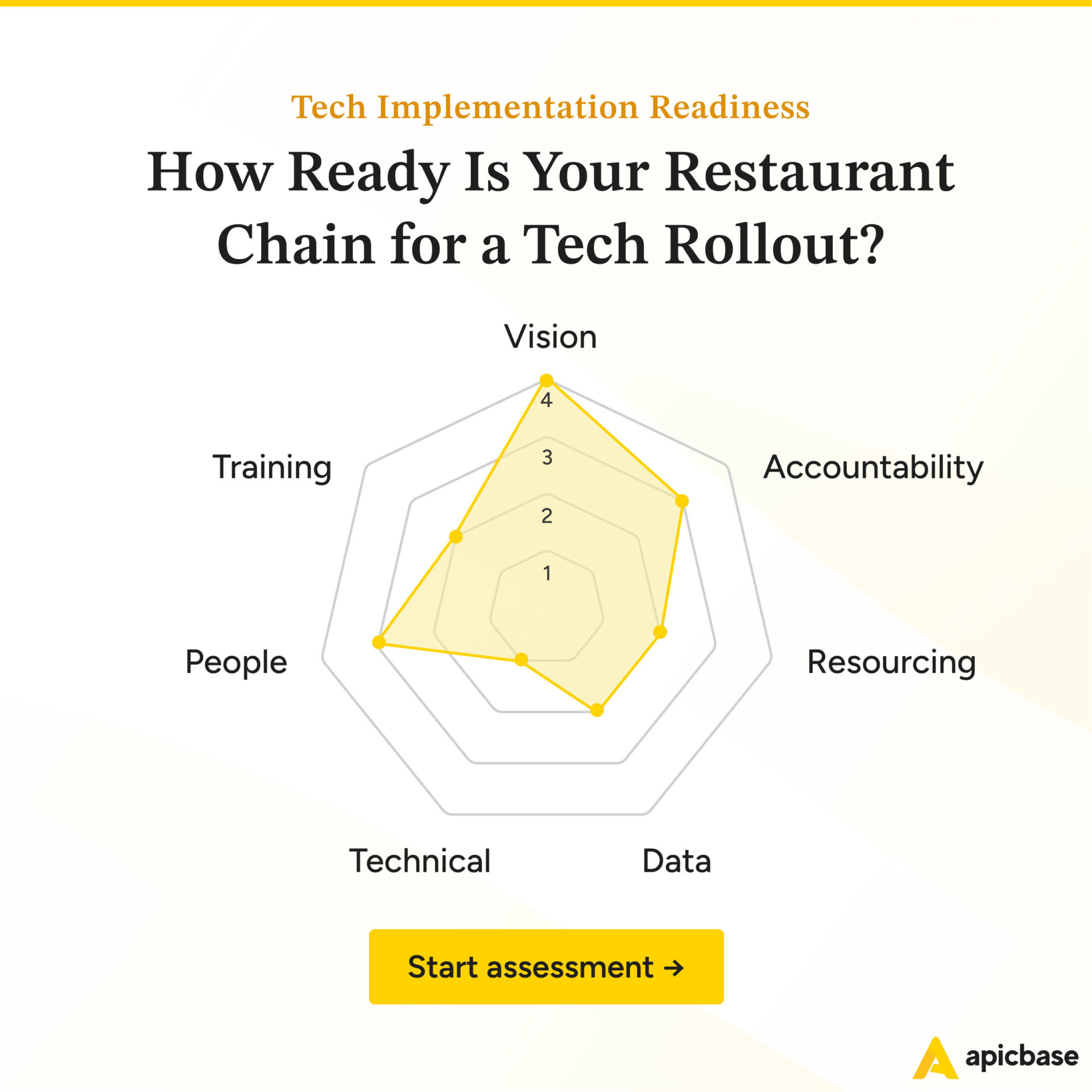For some, a fun dinner can quickly turn into a trip to the emergency room—or worse—if they consume an allergen that triggers a severe reaction.
Approximately 10% of adults and 8.3% of children suffer from food allergies, so it is not a minor issue. This figure rises to about 20% of the population when considering people with food intolerances and sensitivities. For these individuals, allergens can often trigger symptoms similar to, but milder than, those of food allergies.
People with severe food allergies scrutinise every bite they take. They have become experts out of necessity, as their safety depends on it. Yet, they still need access to accurate information to make informed decisions.
‘Does the pesto contain nuts?’ Their night out—and sometimes their life—depends on your answer.
This means that effective food allergen management is crucial for restaurants and catering businesses.
Clear allergen labels are not just expected by customers—they’re often required by law. High-profile incidents in restaurants and foodservice outlets have further raised public awareness about dietary needs and the importance of food allergen management.
Yet, only 58% of restaurant operators say they feel confident about their food allergen management practices.
Worries include:
- uncertainty about new laws and regulations on food allergens;
- difficulties when it comes to managing allergens across multiple outlets;
- steps that need to be taken to eliminate liability for allergy incidents;
- complexities involved in staff training and proper allergen communication.
This guide aims to address those concerns.
It helps you manage allergens and looks at the tools you need to do so well, such as allergen management software. This software keeps track of the allergens in your ingredients and recipes, which is particularly useful in larger, more complex restaurant operations.
Using the guide and the right tools helps you keep your meals safe. It also helps to protect your business, keeping it safe from liability and reputational harm.
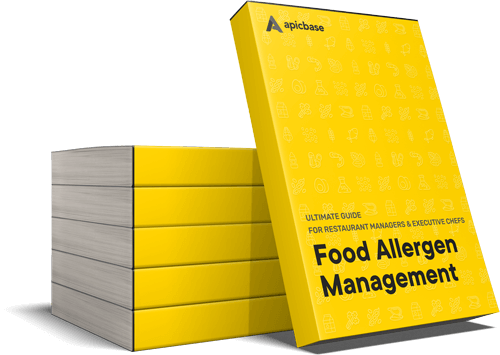
Get the Ultimate Guide to Allergen Management for Restaurant Managers & Executive Chefs
A step-by-step guide for hospitality professionals to identify allergens, educate staff, inform customers and comply with allergen regulations.
What is a Food Allergy?
A food allergy reaction happens when a person’s immune system responds adversely to proteins in certain foods. Even the tiniest amount of allergen protein can set it off (generally, there is no safe amount), and the symptoms include:
- Itchy mouth,
- Skin blotches and hives
- Swollen lips and face,
- Difficulty breathing,
- Coughing and wheezing,
- Nausea, cramps, and vomiting,
- Throat tightening
An allergic reaction’s worst outcome is anaphylactic shock. Blood pressure plunges, and airways constrict, obstructing airflow. The only effective treatment is an epinephrine injection, followed by a trip to the emergency room.
There’s no exact data on the worldwide prevalence of food allergies, but they’ve been on the rise for the past 30 years. According to a World Health Organisation (WHO) study, 10% of adults are allergic to at least one food (and 8,3% of children).
As a restaurateur, you need to be aware that food allergies are not food preferences. They cause discomfort and many health symptoms, which can lead to the need for medicine or even a hospital visit.
The need for allergen management and ingredient tracking is clear, especially in restaurants. 20% of the population has food intolerances and sensitivities, which often trigger similar but milder symptoms as food allergies.
If a customer has an allergic reaction at your restaurant, call an ambulance right away. After that, you can give antihistamines or epinephrine if needed. Most allergy sufferers carry these when eating out, but you can also invest in an on-site antihistamine/Epi-Pen station.
Food allergies are not food preferences. They cause serious discomfort and numerous health symptoms.
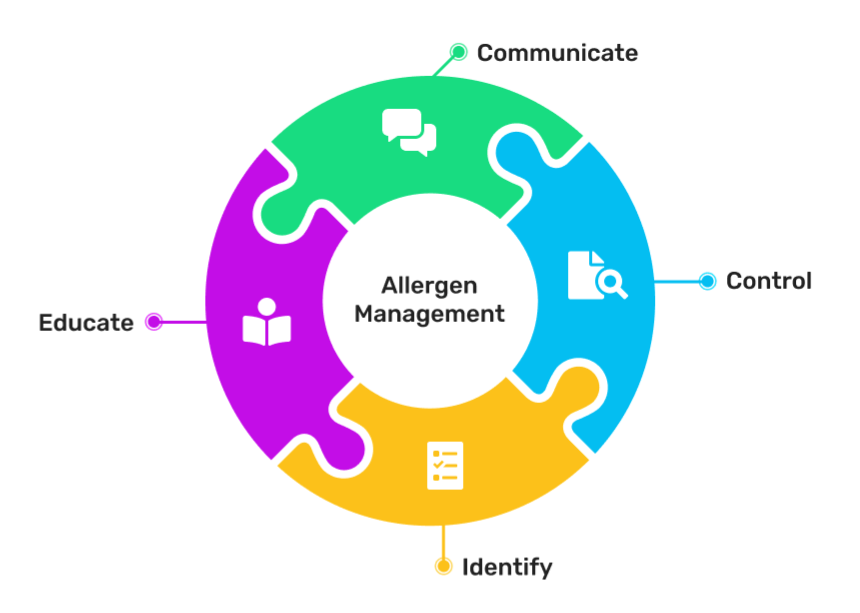
What is Allergen Management in Restaurants and Foodservice?
Allergen Management is a documented system that restaurants and other food businesses need to develop to identify and control food allergens in their recipes, train employees on handling allergenic ingredients, and communicate the risk and presence of food allergens in meals to customers.
Food Allergen Laws & Regulations
The first step in developing a comprehensive allergen management plan is to understand your local laws and regulations and how they apply to eating establishments.
If you’re having trouble navigating through this dense forest of directives and articles, clauses and subclauses,
here’s a quick rundown of the universally applicable essentials:
- You’re required to serve food that is safe for consumption, and the handling and preparation of which adheres to Codex HACCP principles (the European Union) or general food safety principles (the US and other countries).
- In all EU countries, including the UK (and some US states), you need to clearly communicate the presence of any potential food allergens in your menu items. This is easily done by visibly featuring food allergy notices in your establishment.
- Additional allergen information should be made available to those guests who ask for it. In most cases, this is done verbally (which is why allergen training for servers is essential), but you will also be in compliance if you use menus that include allergy-specific information or specialized allergen matrices.
Compliance with allergen-specific laws becomes a little more labour-intensive if your operation is international because you have to deal with different types of rules and inspections.
Still, it’s not as complex as you might think when you first start sifting through everything.
For example, this requirement about food allergen notices being visibly featured on the premises is a law in the European Union but merely a recommendation in other countries.
And, while you might be under the impression that your staff must know absolutely everything about food allergens, that simply isn’t true.
In the US, they need to demonstrate knowledge of food allergens and the adverse health symptoms these can cause, which is not explicitly asked for in the EU allergen legislation (nicely summarized here on the UK’s Food Safety Agency website).
Generally, legislators are wary of putting undue burden on restaurants when it comes to food allergens.
At the end of the day, it is the customer’s responsibility to let you know about their allergy, and your responsibility to accurately and timely communicate allergen risks (in writing and/or verbally), without misleading them.
If you can’t provide a safe meal to an allergy sufferer, you have to say that in no uncertain terms.
However, thanks to legal jargon and legislative mumbo jumbo, most restaurateurs think that allergen management in restaurants is complicated and that it opens them up to all sorts of liability lawsuits.
In reality, you can protect yourself (and your customers) by focusing on two things:
- designing and implementing knowledge and training programs for your staff and
- having an easy, bullet-proof way of tracking all the ingredients that end up in your dishes.
After we take a quick look at pending allergen law changes in the UK, we’ll show you, step by step, how to stay in compliance and reduce (and, hopefully, eliminate) allergy incidents in your restaurant.
Law Changes Affecting Allergen Management in the UK (2021) – Natasha’s Law
Up until recently, the UK followed EU FIC regulation when it comes to allergen labelling, which prescribed different requirements for different types of foods and/or establishments:
- Prepacked foods – full ingredient list must be shown on the packaging. Common allergens need to be emphasized in some way where they appear. Exempt are foods that are made and packed on the premises from which they are being sold.
- Buffet-style loose foods – all buffet dishes need to have a separate ingredient list with allergens clearly emphasized. Listing allergens for the entire buffet without giving specifics is a violation as it doesn’t help allergic people make a safe choice.
- Non-prepacked foods (restaurants) –allergen information needs to be available in written form or presented verbally for every item that contains any of the 14 common allergens.
After the tragic death of Natasha Ednan-Laperouse, a teenager who suffered an allergic reaction after eating a prepacked baguette that contained undeclared sesame seed, the UK is moving to change the law.
This change becomes effective in October 2021 and is known as Natasha’s Law.
The new law will require all establishments that deal with prepacked food for direct sale (PPDS) to include a full ingredient list on the packaging (with allergens emphasized), which was not the case so far.
This labelling process will be labour-intensive for most establishments (bakeries, restaurants, and cafes) that sell high volumes of prepacked sandwiches, meat pies, salads, or similar.
However, you can easily streamline it (while preventing manual labelling mistakes) by using apps specifically designed to add allergy tags to ingredients and recipes, and printing those in bulk to use across all your locations.
We can help you with this. Apicbase’s Recipe Development and Menu Engineering Software has built-in costings, allergen, nutritional values, and carbon footprint labelling.
14 Common Food Allergens
The EU and UK legislation recognise 14 common food allergens
Celery
Cereal (Gluten)
Crustaceans
Egg
Fish
Lupin
Peanuts
Soya Beans
Cow Milk
Molluscs
Mustard
Tree Nuts
Sesame Seeds
Sulphur Dioxide (Sulphites)
In the US, the official list is just eight-strong – molluscs and crustaceans are clumped together as “shellfish”, and five foods are not included.
This exclusion is not unusual—scientists have identified as many as 160 food allergens so far, and most of them are not legislated since the so-called Big 8 group is responsible for more than 90% of food allergy incidents.
Official allergen lists are important because they tell you which allergens you need to declare to comply with the law.
They also give guidance on the alternative names some allergens can be found under (such as whey for dairy-specific protein or histidine for egg-specific protein), which lets you adequately educate and train your waitstaff.
How to track allergens in recipes and menus?
Keeping track of allergens in recipes and menus is a key component of your allergen management program.
It might seem obvious, but it is too important to skip over: you need to know the allergens in every morsel of food you serve.
How else will you be able to inform customers properly?
Any food allergen management program worth its salt must include a matrix with menu items and their allergens.
This way, front- and back-of-house staff can quickly respond to customer questions. All they have to do is grab the allergen matrix. Find the dish in question and look up the allergens.
Tracking allergens in recipes manually is easiest using a spreadsheet like Excel or Google Sheets.
However, if you are looking for a more futureproof approach, you should consider allergen management software.
Our app keeps track of allergens on all levels—ingredients, recipes, and menus. If you change an ingredient, all levels are updated automatically, and your staff can look up menu items instantly on any device.
Better yet, our API also populates your online ordering pages, kiosks and other apps with updated allergen info.
Apicbase saves your BoH time and boosts your FoH staff’s confidence when helping customers.
Quick heads-up: before you can develop the allergen matrix, you need to know the allergens in your ingredients. You can find them on the packaging, or in your supplier’s allergen documents.
Okay, back to the allergen spreadsheet.
Your allergen spreadsheet in its most basic form should consist of two pages:
- an ingredients list
- an allergen matrix
Let’s start with the ingredients list.
In the first column, you list all the ingredients you use, such as tomato puree from the brand Altoni.
If you are already using an ingredients list for food cost calculations or inventory management, you can re-use that list here.
In the following columns, you list the allergens per ingredient.
It should look like this.

There is no denying it: this part of allergen management is hard work. The good news is, once you know the allergens per ingredient, building your allergen matrix is easy.
Let’s move on to the allergen matrix.
It has two main components:
- your menu items or dishes
- the 14 common food allergens
What you need to do now is pull up your recipes, check the ingredients per dish, cross-check with the ingredients list to find the allergens and fill out the matrix.
It should look like this:

Now you have an overview of your menu items and the allergens they contain.
If you don’t want to create your own allergen matrix, feel free to download our ready-made PDF template.
You can download the free allergen matrix PDF template here (it’s below the food allergy notice templates).
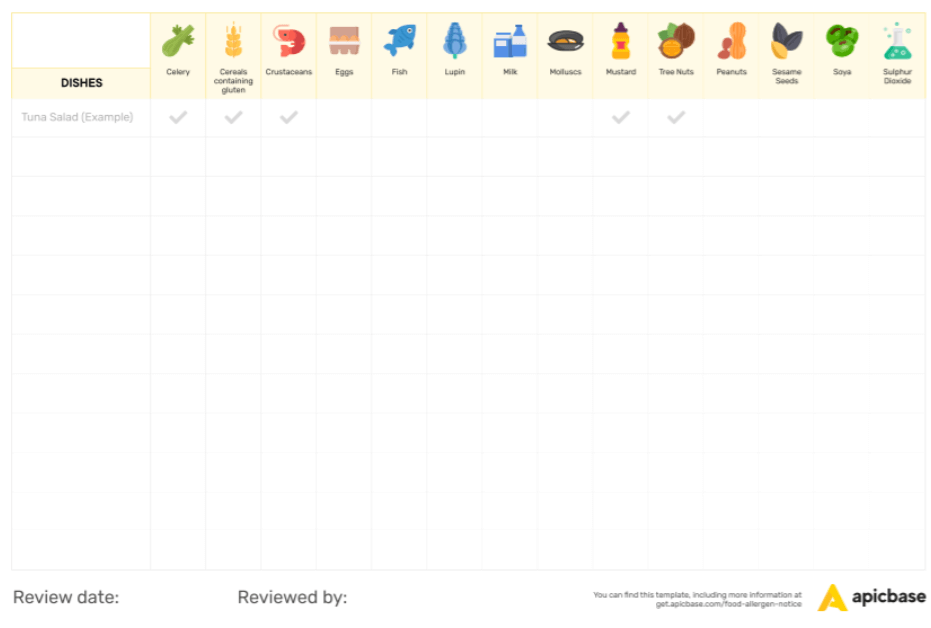
With an allergen database that’s available to everyone (incorporated into an allergen management app, for example), keeping track of allergens – no matter what name they appear under – is less time-consuming and complicated.
However, an app can’t do all the work, which brings us to the core of all successful allergen management programs – allergen training.

Get the Ultimate Guide to Allergen Management for Restaurant Managers & Executive Chefs
A step-by-step guide for hospitality professionals to identify allergens, educate staff, inform customers and comply with allergen regulations.
Allergen Training for Managers, Servers, and Chefs
The goals of a comprehensive allergen training program are three-fold:
- To allow you to create bespoke meals that are safe for allergic customers;
- To limit your liability in the case, a customer does suffer an allergic reaction, and;
- To ensure that your employees can react swiftly and decisively (and save a life).
In most cases, there is no one-size-fits-all allergen training, meaning that you can’t walk into a restaurant, check out what they’re doing, copy their policies and procedures, and call it a day.
And honestly, you wouldn’t even want to do that. According to the Environmental Health Specialists Network (EHS-Net) study, less than half of all food service workers go through any form of allergy training, meaning that the restaurants that do this right are few and far between.
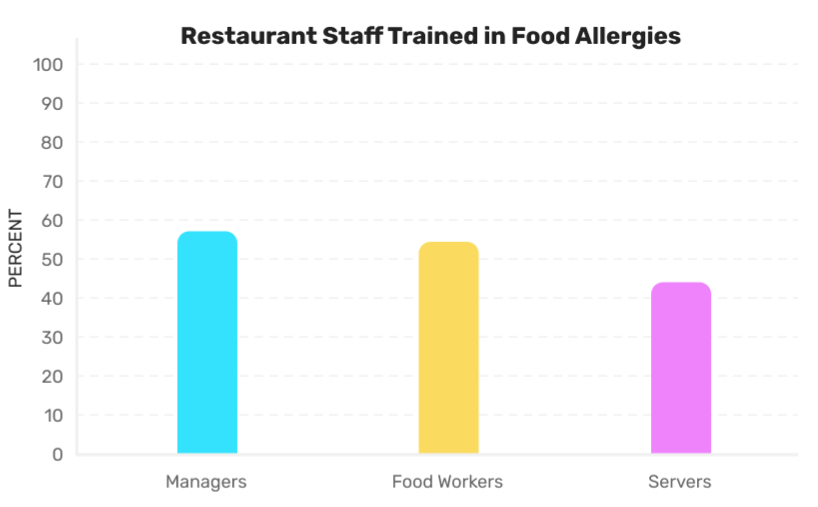
Yours can be one of those restaurants, but to get there, you need to review your operations, identify weak spots, and create a training plan that minimises or eliminates those weak spots.
Here are five areas your food allergen training needs to address:
- Supply chain management—Allergen management starts with knowing what comes into your kitchen. Make sure that your allergen training exposes every kitchen staff member to the orders and delivery process. They should be able to confidently receive deliveries and check them for quality, inconsistencies, and allergen information.
- Allergen-specific knowledge—As we already mentioned, some allergens are often labelled under a different name. Run through these less common names with your staff regularly, and have a clear visual reminder in the kitchen (such as this food allergen poster).
- Open and honest communication—Train your waitstaff to ask about potential allergies and to talk to the kitchen staff if menus and allergen matrices are unclear. Under no circumstances should anyone guess whether a dish is safe or not—if they don’t know (and can’t find out), they need to tell the customer clearly and unequivocally.
- Emergency allergy response—If an allergy incident happens in one of your restaurants, you need to be reasonably confident that your staff can respond to it properly. The most important thing they can do is phone the emergency services and accurately describe the allergic reaction. If you keep an Epi-Pen on the premises, make sure that everyone knows when and how to use it.
- Cross-contact prevention—Cross-contact in the kitchen is usually the main cause of allergic reactions in restaurants. Manage it by identifying incident hot spots, having designated prep areas and utensils for allergen-free meals, and by implementing a rigorous hygiene policy. Just by doing that, you will be doing more than 85% of other restaurants that participated in the aforementioned EHS-Net study.
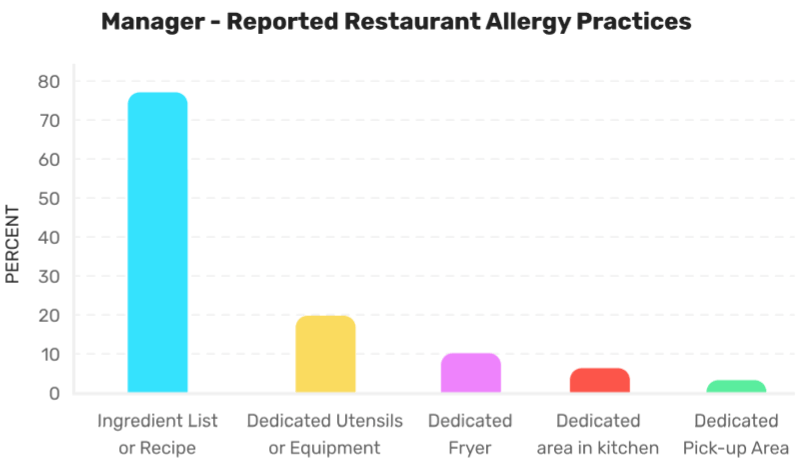
As with any other employee training program, you want to set manageable goals and occasionally test your employees.
The questions that we included in this comprehensive write-up on food allergy training in restaurants can come in handy.
Can Technology Help You Manage Food Allergens More Easily?
The short (and obvious) answer to this question is yes—with the right tools, you can streamline and improve your restaurant’s food allergen management processes.
Typically, this is what happens when owners and chefs start using tech and apps specifically designed to minimise allergen management errors:
- Allergen management becomes less time-consuming and labour-intensive,
- Allergen reports are always up-to-date,
- Mistakes due to miscommunication are drastically reduced (fewer human errors),
- Staff have instant, multi-device access to allergen information for all menu items,
- Multiple outlets are always on the same page (ingredients, allergen lists, recipes, menus),
- There’s no need to constantly check in with staff in regards to allergens.
However, despite the benefits of allergen management digitisation, many food service businesses still opt for manual allergen tracking.
71% of operations still rely on pen and paper for allergen management.
A 2020 Access survey of more than 120 UK-based restaurants, hotels, and bars found that 71% of them still use pen and paper.
Larger operations tend to adopt technology more easily, but the numbers in that group also leave a lot to be desired – just 55% of operations with 50+ sites use a dedicated allergen management solution.

Whether you’re small or big, you want to make sure that you’re making it easy on yourself and your team.
Technology in the kitchen helps you save time, minimise mistakes, and stay compliant with laws and regulations.
Take a look at this hypothetical situation in which you’ve changed one (usually inconsequential) ingredient in a single recipe.
Compare the time needed—and the number of opportunities for accidental errors—to do this all manually to using a food allergen management app.
Example
You run a multi-outlet business, and you decide to make a tiny change to one of your recipes – instead of “X sauce brand” (contains sesame oil), you’ll now use “Y sauce brand” (contains shellfish).
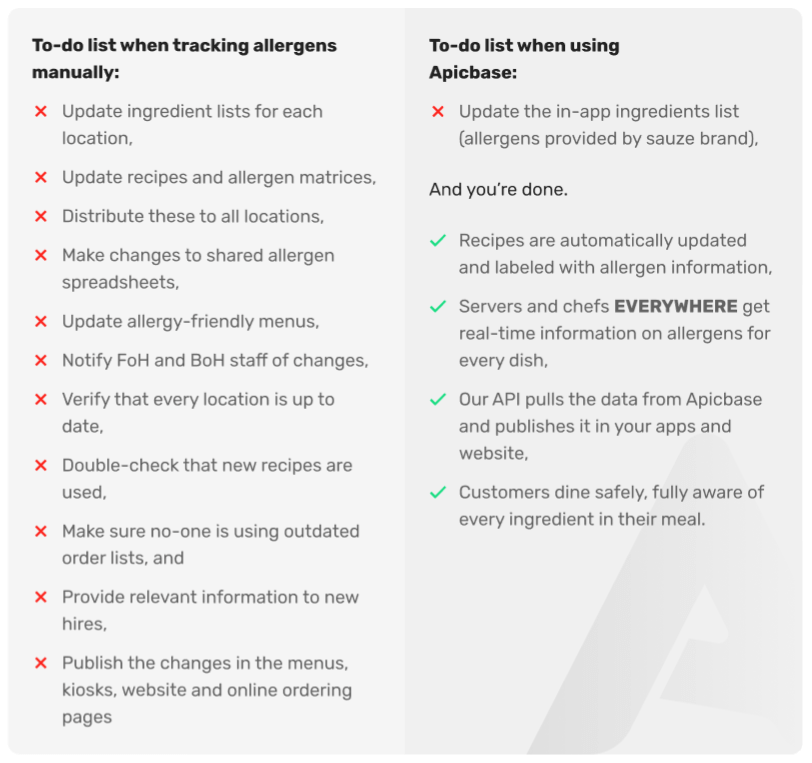
How would you rather do it?
It’s obvious that the digital approach to allergen management speeds up the process, makes it less error-prone, and allows you to easily and quickly make changes across multiple locations.
However, we’ll be fair and say that most operators are still concerned about how they handle allergens in their restaurants, regardless of if they do it manually or use dedicated software.
Due to the nature of the beast, some anxiety is to be expected – you simply can’t be 100% sure that you’ve eliminated every possibility for cross-contamination or human error.
That said, it’s important to note that places using technology are more confident in their allergen management practices.
When asked about it, most servers note that allergen communication is far less stressful if they have reliable software that allows them to double-check everything on the spot.
It eliminates second-guessing and mistakes and saves time because they don’t have to constantly check things with the kitchen staff.
Let’s wrap things up
You now have some very specific insights into how to easily manage food allergens in your restaurant, as well as a step-by-step process that tells you what, when, and how to do it.
Before we part ways, we’ll run through the key points one more time:
- Make sure you know specific laws that dictate how you need to handle food allergens;
- Step up allergen communication – use allergy and intolerance notices, and instruct your waiters to ask about allergies when taking orders;
- Educate and train employees on how to safely handle sensitive ingredients, and how to recognize the symptoms of an allergic reaction (and respond to them);
- Use technology to streamline allergen management, save time, and reduce miscommunication and human errors.
With the right allergen management system in place, you’re not just protecting your business and your customers. You’re also building an allergy-friendly brand that people will notice and reward.
Allergy sufferers are fiercely loyal customers. If your staff is communicative, honest, and accommodating in the slightest, you will earn a new regular patron every time you serve an allergic person.

Get the Ultimate Guide to Allergen Management for Restaurant Managers & Executive Chefs
A step-by-step guide for hospitality professionals to identify allergens, educate staff, inform customers and comply with allergen regulations.




